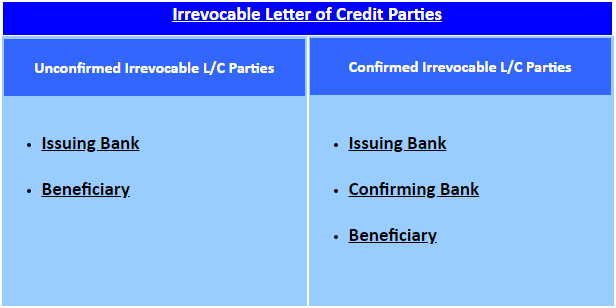Transferable letters of credit are a tool used by trading companies, or other third parties, to facilitate a trade transaction. (1)
Transferable letters of credit are sort of documentary credits which can be used in situations where middlemen are playing a certain role.
How Does a Transferable Letter of Credit Work:
Usually middlemen (first beneficiaries) do not have enough capital establishment to buy the goods from their sources (second beneficiaries) before they re-sell them to their final customers (applicants).
If the final buyer finds it valuable working with a middleman, then he can let the middleman benefit from his credibility by supplying him a transferable letter of credit.
The middleman have the part or all of the transferable letter of credit transferred to his supplier, who has gained considerable payment assurance to ship the goods.
The supplier can receive its payment portion in exchange for the complying documents stated in the letter of credit.
The middleman is entitled to substitute its own invoice for the one that is presented by the supplier and collects the difference as his profit.
Transferable Credits:
- Transferable letter of credit is a special type of l/c which is suitable for triangle trade.
- Triangle trade is a type of international business transaction in which a middleman sits between exporter and importer.
- Middlemen or trade brokers have limited finance facilities. As a result, they have to rely on their buyers’ finance support such as a transferable letter of credit.
- Process of the transferable lc is as follows in a very simple term. Middleman’s buyer open a transferable letter of credit in favor of the middleman. Then middleman transfers a part of this l/c to his supplier. The difference between two l/cs is the net profit margin of the middleman.
- Banks play a key role on transferable letters of credit.
- UCP 600 rules have special articles about transferable letters of credit.
Letter of Credit Rules Regarding Transferable Credits:
According to the latest letter of credit rules, UCP 600 Article 38 which is titled as Transferable Credits
a. A bank is under no obligation to transfer a credit except to the extent and in the manner expressly consented to by that bank.
b. For the purpose of above mentioned article you can find some important definitions of transferable letters of credit as follows:
- Transferable credit means a credit that specifically states it is “transferable”. A transferable credit may be made available in whole or in part to another beneficiary (“second beneficiary”) at the request of the beneficiary (“first beneficiary”).
- Transferring bank means a nominated bank that transfers the credit or, in a credit available with any bank, a bank that is specifically authorized by the issuing bank to transfer and that transfers the credit. An issuing bank may be a transferring bank.
- Transferred credit means a credit that has been made available by the transferring bank to a second beneficiary.
c. Unless otherwise agreed at the time of transfer, all charges (such as commissions, fees, costs or expenses) incurred in respect of a transfer must be paid by the first beneficiary.
d. A credit may be transferred in part to more than one second beneficiary provided partial drawings or shipments are allowed.
A transferred credit cannot be transferred at the request of a second beneficiary to any subsequent beneficiary. The first beneficiary is not considered to be a subsequent beneficiary.
e. Any request for transfer must indicate if and under what conditions amendments may be advised to the second beneficiary. The transferred credit must clearly indicate those conditions.
f. If a credit is transferred to more than one second beneficiary, rejection of an amendment by one or more second beneficiary does not invalidate the acceptance by any other second beneficiary, with respect to which the transferred credit will be amended accordingly. For any second beneficiary that rejected the amendment, the transferred credit will remain unamended.
g. The transferred credit must accurately reflect the terms and conditions of the credit, including confirmation, if any, with the exception of:
– the amount of the credit,
– any unit price stated therein,
– the expiry date,
– the period for presentation, or
– the latest shipment date or given period for shipment,
any or all of which may be reduced or curtailed.
The percentage for which insurance cover must be effected may be increased to provide the amount of cover stipulated in the credit or these articles.
The name of the first beneficiary may be substituted for that of the applicant in the credit.
If the name of the applicant is specifically required by the credit to appear in any document other than the invoice, such requirement must be reflected in the transferred credit.
h. The first beneficiary has the right to substitute its own invoice and draft, if any, for those of a second beneficiary for an amount not in excess of that stipulated in the credit, and upon such substitution the first beneficiary can draw under the credit for the difference, if any, between its invoice and the invoice of a second beneficiary.
i. If the first beneficiary is to present its own invoice and draft, if any, but fails to do so on first demand, or if the invoices presented by the first beneficiary create discrepancies that did not exist in the presentation made by the second beneficiary and the first beneficiary fails to correct them on first demand, the transferring bank has the right to present the documents as received from the second beneficiary to the issuing bank, without further responsibility to the first beneficiary.
j. The first beneficiary may, in its request for transfer, indicate that honour or negotiation is to be effected to a second beneficiary at the place to which the credit has been transferred, up to and including the expiry date of the credit. This is without prejudice to the right of the first beneficiary in accordance with sub-article 38 (h).
k. Presentation of documents by or on behalf of a second beneficiary must be made to the transferring bank.
References:
- A guide to doing business abroad, International Trade Procedures, Wells Fargo, P:28







